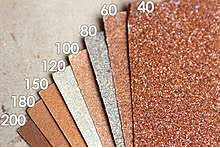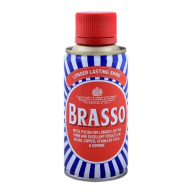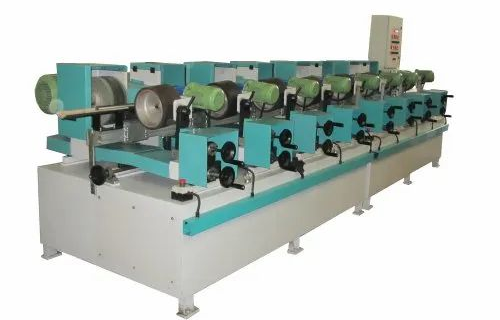How to Polish Metal | 8 Ways
 Aug 08,2023
Aug 08,2023

A lustrous look in metals like Stainless Steel or Brass is often desired in order to give them an aesthetic appeal. This can be achieved by polishing metals. Besides aesthetics, polishing is also done for sanitary and hygiene purposes for healthcare and food sectors. It can minimize contamination with impurities that may reside inside containers or delivery vessels. It also increases corrosion resistance of the metals
Is it Easy to Polish Metal?
Polishing can be easier or difficult depending on the type of materials, desired surface finish, intricacy of geometry and the technique that is adopted. Surface finish designations range from “#1 finish” till “#8 finish”, with an increasing order of luster. #1 finish is very similar to mill finish and it is just descaled without any polish, however, #8 finish is mirror-like finish with an extreme level of luster. Naturally, a finish close to mirror-like appearance would be more laborious and difficult.
Polishing intricate components is always more difficult than simpler geometries. For polishing these components, it is advised that these be broken-down into simpler geometries for polishing and then these break-downs be assembled to make the final part. This situation is ideal for the components where mechanical fasteners are to be used for assembly. However, components where welding or brazing is used for assembly, discoloration may occur. So, polishing before assembly may be avoided. If it must be the case then small tools like Dremel can be used to polish and buff the discolored areas. Details will be discussed later in this article.
Choice of a good polishing technique can optimize the process as well as reduce the labor. For instance, customized polishing machines are more efficient than hand-held tools. Similarly, the right choice of abrasive media or buffing compound can make the process less laborious and efficient. The above factors are to be kept in mind before polishing metal components.
How to polish metal to look like chrome
Chromium, chromium alloys, and metals like stainless steel in which chromium is a significant alloying component can be polished and buffed till it looks like chrome. Actually, these have a self-healing chromium oxide layer which is non-porous and passive in nature. This adherent layer has a shiny-silver color. Without polishing, it may have a matte finish and some uneven marks on the surface. Several abrasives are applied, starting from coarser ones and ending up to finer ones, with decreasing the level of coarseness in each subsequent stage. Buffing is done to give it a chrome-like lustrous look. More details will be discussed in the subsequent sections.
Metal Polishing Tools and Equipment
There are many tools, accessories and equipment for polishing metals, ranging from DIY tools like emery papers or Dremel to industrial machines like automatic tubes and sheets polishers. A careful choice for the right tools and equipment be made keeping in view:
- Capital investment
- Scope of use
- End-user application
- Process requirements
A descriptive explanation of 8 techniques that can be employed to polish metals can be found in the next section.
8 Way to Polish Metal
Here are 8 ways with which metals can be polished to a mirror finish:
By hand
It is one of the quickest and easier to adopt DIY method composed of cleaning and polishing. At first, metal component is thoroughly washed with a soap emulsion or a detergent solution using wipes. Then it is cleansed with a microfiber cloth. Drying before polishing is necessary, so make sure that it is fully dried. Apply a small quantity of proprietary polish compound and leave it for a few minutes. It will make an even layer on the top surface. Next work the surface with a fine microfiber cloth to remove excess polish and give it a shiny look.
Polish with sandpaper
Sandpapers come in a variety of abrasive grits ranging from as coarse as 36 grits to as fine as 3000 grits. Depending on the condition of the workpiece, a starting abrasive grit can be chosen. For very rough workpieces, for example workpieces in as-cast state, 36-100 grit may be used for deburring of edges, removal of excess material and uniformity of surface. For 2B (cold rolled) finish a finer grit can be used for starting the process.

Figure 1: Sand paper grits (coarse to fine)
The sandpaper is rubbed in a single direction until the surface appears to be uniform and all the scratch lines of the sandpaper on the workpiece seems to be parallel. Next, a finer girt sand paper is rubbed in a direction perpendicular to the previous sandpaper direction. This will remove the coarse scratches of the previous sand paper and it’ll introduce finer scratches of the current sandpaper. When all the scratch lines appear to be parallel in direction, move to an even finer sandpaper and repeat the step, i.e., remove scratch line of the previous paper with this finer one.
Note that in subsequent stage of switching to a finer sandpaper, scratches are becoming finer and these are also changing directions. After many intervals, when a very fine grit, let’s say in an order of 3000 grits is achieved, scratch lines are not visible with naked eye and surface seems to be very shiny. Diamond paste polishing can be used as an additional step to enhance the surface luster.
Below chart can be consulted to convert the abrasive numbers between different international standards:
ABRASIVE GRADE COMPARISION CHART
|
Micron (μ) |
JIS |
ANSI |
FEPA |
Flexible |
Diamond |
Trizact (μ) |
Emery |
|
Avg Size |
(Mesh) |
(Grit) |
(P-Grade) |
Diamond (μ) |
Cloth (μ) |
|
|
|
|
|
12 |
P12 |
|
|
|
|
|
|
|
16 |
P16 |
|
|
|
|
|
|
|
20 |
P20 |
|
|
|
|
|
|
|
24 |
P24 |
|
|
|
|
|
|
|
36 |
P36 |
|
|
|
|
|
|
|
40 |
P40 |
|
|
|
|
|
|
|
50 |
P50 |
|
|
|
|
|
250 |
60 |
60 |
P60 |
M250 |
|
|
|
|
200 |
80 |
80 |
P80 |
|
|
300 |
|
|
160 |
100 |
100 |
P100 |
|
165 |
A200 |
|
|
125 |
120 |
120 |
P120 |
M125 |
125 |
A160 |
|
|
100 |
150 |
150 |
P150 |
|
|
A130 |
|
|
80 |
180 |
180 |
P180 |
|
|
A110 |
3 |
|
75 |
200 |
|
|
|
|
A100 |
|
|
|
220 |
|
P220 |
M74 |
70 |
A90 |
|
|
60 |
240 |
220 |
P240 |
|
|
A85 |
2 |
|
|
|
|
P |
|
|
A80 |
|
|
|
|
|
P280 |
|
|
A75 |
|
|
50 |
280 |
240 |
|
|
|
A65 |
|
|
|
|
|
P320 |
|
|
A60 |
|
|
|
320 |
280 |
|
|
|
|
1 |
|
40 |
360 |
320 |
P360 |
|
|
A45 |
|
|
|
400 |
360 |
P500 |
M40 |
45 |
|
1/0 |
|
35 |
|
|
P600 |
|
|
A35 |
|
|
30 |
500 |
400 |
|
R30 |
|
A30 |
2/0 |
|
|
|
|
P800 |
|
|
A25 |
|
|
20 |
600 |
500 |
P1000 |
|
30 |
A20 |
3/0 |
|
|
800 |
|
|
M20 |
|
|
|
|
|
1000 |
600 |
|
|
|
A16 |
|
|
15 |
1200 |
800 |
P1200 |
|
15 |
|
|
|
|
|
|
|
|
|
|
|
|
12 |
1500 |
1000 |
P1500 |
|
|
|
|
|
|
1800 |
|
|
M10 |
9 |
A10 |
|
|
9 |
2000 |
1200 |
P2000 |
R10 |
|
|
4/0 |
|
6 |
|
1400 |
|
|
|
A6 |
|
|
5 |
2500 |
|
P2500 |
|
|
|
|
|
|
3000 |
|
|
|
6 |
|
|
|
3 |
4000 |
1800 |
P3000 |
|
|
A3 |
|
|
|
6000 |
|
|
|
|
|
|
|
|
7500 |
|
|
R2 |
|
|
|
|
1 |
8000 |
2000 |
|
|
3 |
|
|
|
0.5 |
|
|
|
|
|
|
|
|
0.3 |
10000 |
|
|
|
|
|
|
|
0.1 |
25000 |
|
|
|
|
|
|
|
0.05 |
50000 |
|
|
|
0.5 |
|
|
Use Brasso metal polish
Brasso is proprietary liquid metal polish for removing dust or tarnish from metals like copper, brass, bronze, chromium and stainless steel.

Figure2: Proprietary Brasso Liquid
Before intending to use it make sure that the surface it actually metal. Apply it on a small patch first to see the results. Wet a portion of a clean cloth with Brasso and rub it onto the surface in circular motions and wipe it with another clean cloth. Wiping should be done before drying, otherwise dirt all the soluble dirt in Brasso will again set onto the surface. Make sure to remove dirt from nooks and corners. Brasso is inflammable so contact with fire or heated objects must be prevented.
Polish with a buffing wheel
Choose the right buffing compound for your desired material. V Attach the buffing wheel to your machine and apply a small quantity of buffing compound onto it. Rotate the buffing wheel onto the metal surface with a low pressure in the direction of rotation of the workpiece. This is called ‘coloring’ motion. Continue to work on the surface until surface gets brightened and shiny. For some applications, a single buffing compound is sufficient. For others, iterations with coarse-to-fine strategy are necessary.
Below table will help you in selection:
|
Material |
Compounds (Coarse to Fine) |
|||||
|
|
Black Emery |
Brown Tripoli |
White Rouge |
Green Stainless |
Red Rouge |
Blue All Purpose |
|
Acrylics |
|
|
|
|
|
* |
|
Aluminum |
O |
O |
* |
O |
|
O |
|
Brass |
O |
O |
O |
O |
* |
O |
|
Copper |
O |
O |
O |
O |
* |
O |
|
Gold |
|
O |
O |
|
* |
O |
|
Iron |
O |
|
|
* |
|
O |
|
Nickel |
O |
|
|
O |
* |
O |
|
Pewter |
O |
O |
|
|
* |
O |
|
Platinum |
|
|
O |
* |
|
O |
|
Silver Plate |
|
O |
O |
|
* |
O |
|
Steel |
O |
|
|
* |
|
O |
|
Nickel/Chrome Plate |
|
|
|
|
O |
* |
|
Brass/Copper Plate |
|
O |
O |
|
* |
O |
|
Stainless Steel |
O |
O |
O |
* |
|
O |
|
Plastic |
|
O |
O |
|
O |
* |
|
Rubber |
|
* |
|
|
|
O |
|
Horn |
|
* |
|
|
|
O |
|
Wood |
|
* |
|
|
|
O |
How to polish metal with a Dremel?
Dremel comes with a polishing kit and polishing compound. Attach a felt or cloth buffing accessory with the Dremel and apply some buffing compound onto it. The procedure is very similar to the buffing wheel process except for the fact that it can be used for small object, intricate shapes and hard-to-reach areas. Follow the above-mentioned procedure. As per manufacturer’s recommendation start with 5000 rpm and step-up the rotation speed steadily until it reaches 15000 rpm.
Metal polisher machine
As shown in figure, metal polishing machines have several stands or heads.

Figure 3: Eight-Heads Round Pipe Polsihing Machine
These are most commonly for uniform or axis-symmetric shapes like tubes or pipes. Metal is fed from one end. It passes through several polishing stands and at last it comes out fully polished. Depending on the applications machines can be 10-heads, 12- heads or may be 16- heads. The initial heads have hard-cemented buffing wheels, for instance, Sisal wheels. Polishing compound is applied on the initial wheels and these work polish on the metal surface. The subsequent heads have softer wheels, for instance, cotton wheels or wind-cloth wheels. These remove excess polish and give a bright and shing appearance.
Electropolishing
Electropolishing also known as reverse electroplating uses DC electrical current to remove a very thin layer in the order of microns to give a smooth and polished surface. It is most commonly applied to stainless steel, but it is equally good for non-ferrous metals like titanium, aluminum, zinc, copper etc.
The metal component to be polished is immersed in an electrolytic solution of high-viscosity mixture of sulfuric acid and phosphoric acid. The positive terminal of DC power rectifier is connected to be metal part. Cathode is typically made&
 Tel/WeChat:
Tel/WeChat:  Email:
Email: 
 Home
Home
 How to Brush Aluminum: A Step-by-Step Guide
How to Brush Aluminum: A Step-by-Step Guide 







